Timeline of the revival of ancient drama
1867
The first professional performance of ancient drama
In 1867, the first professional performance of an ancient drama in the newly-founded Greek State is presented. It is Antigone by Sophocles. It is organised by the University of Athens, and is performed for the wedding of King George I to Olga Constantinova of Russia. The tragedy was translated by the scholar and writer, Alexandros Rizos Rangavis.
For the first time, professional actors participated, along with the amateur students.
The lead role was played by the famous actress of the time, Pipina Vonasera. The performance took place in the Odeon of Herod Atticus. During the performance the audience were given treats, in an effort to revive the ancient custom.

The Odeon of Herod Atticus around 1867. Photographic Archive of the Benakis Museum

The Odeon of Herod Atticus around 1867. Photographic Archive of the Benakis Museum
1900
The first performance of an ancient comedy
Aristophanes' The Clouds is the first performance of a comedy in modern Greece. The driving force behind it was the satirical poet Georgios Souris, who was responsible for both the translation and direction of the play.
The play is staged at the Municipal Theatre of Athens and the Municipal Theatre of Piraeus. Women were banned from the performance.

The group of Georgios Souris Athens, 1896. Hellenic Literary and Historical Archive (E.L.I.A. – M.I.E.T.) Photographic Archive

The group of Georgios Souris Athens, 1896. Hellenic Literary and Historical Archive (E.L.I.A. – M.I.E.T.) Photographic Archive
1901
The Nea Skene of Konstantinos Christomanos
Nea Skene (New Stage) and its founder, the scholar, Konstantinos Christomanos, makes its appearance with Alcestis by Euripides. He undertook the organisation of all the performances. He was even involved in the translation of texts into demotic Greek and the design of the scenery and costumes. Christomanos' multi-faceted approach highlighted for the first time the dominance of the director in the professional theatre.

Konstantinos Christomanos, 1901. National Hellenic Research Foundation / IIE

Konstantinos Christomanos, 1901. National Hellenic Research Foundation / IIE
1903
Oresteia in Demotic Greek
The performance of the Oresteia by Aeschylus at the Royal Theatre is an important theatrical event. The director of the performance was Thomas Economou. He and Christomanos are considered the first 'professional' directors of the new Greek theatre.
The play was translated into demotic Greek from a German version of the original text. This choice became a source of conflict between two opposing camps: those who supported the use of kathareuousa, a form of the modern Greek language conceived as a compromise between Ancient Greek and the Demotic Greek, and those who supported the demotic form. This linguistic disagreement is also known as the Glossiko Zetema (The Greek Language Question). Philology students and supporters of kathareuousa, led by the university professor, Georgios Mistriotis, reacted violently. Incidents and clashes broke out, resulting in one death!

The programme of the performance Oresteia by Aeschylus, 1903. Archive of the Theatre Museum of Athens

The programme of the performance Oresteia by Aeschylus, 1903. Archive of the Theatre Museum of Athens
1919
Oedipus Rex directed by Fotos Politis
Oedipus Rex by Sophocles is performed at the Olympia Theatre by the Greek Theatre Society. Fotos Politis translates and directs the play.
It is clear from the performance that the director was trying to adapt ancient theatre to a closed stage. To achieve this, the apron of the stage was enlarged by removing the front rows of seats.
The role of Oedipus was played by Emilios Veakis, one of the top performers of ancient drama in Greece.

Emilios Veakis. Hellenic Literary and Historical Archive (E.L.I.A. – M.I.E.T.) - Aspasia Papathanassiou Archive

Emilios Veakis. Hellenic Literary and Historical Archive (E.L.I.A. – M.I.E.T.) - Aspasia Papathanassiou Archive
1927 and 1930
The Delphic Festivals
On the initiative of Angelos Sikelianos and his wife, Eva Palmer-Sikelianos, the first Delphic Festival is organised in 1927. It includes a performance of Prometheus Bound by Aeschylus, traditional dance competitions and a folk art exhibition. This is the first performance in modern times held in the ancient theatre. In 1930, the event is repeated with the addition of The Suppliant Women by Aeschylus.
Eva Palmer undertook the direction of both productions. For the movements of the chorus, she was inspired by ancient pottery painting and traditional Geek dances. She herself designed and loom-wove the costumes with patterns from Greek art. The music was based on a Byzantine melody.
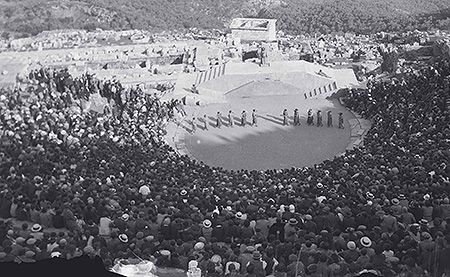
Prometheus Bound by Aeschylus, Delphic Festival, 1930. Photographic Archive of the Benakis Museum (Photographer: Nelly’s).
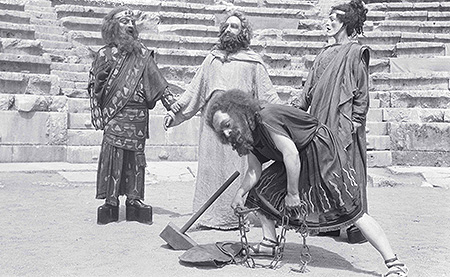
Prometheus Bound by Aeschylus, Delphic Festival, 1930. Photographic Archive of the Benakis Museum (Photographer: Nelly’s).

Eva Palmer
Delfic Festivals, 1930
Hellenic Literary and Historical Archive (E.L.I.A. – M.I.E.T.) Photographic Archive

Prometheus Bound by Aeschylus, Delphic Festival, 1930. Photographic Archive of the Benakis Museum (Photographer: Nelly’s).

Prometheus Bound by Aeschylus, Delphic Festival, 1930. Photographic Archive of the Benakis Museum (Photographer: Nelly’s).

Eva Palmer
Delfic Festivals, 1930
Hellenic Literary and Historical Archive (E.L.I.A. – M.I.E.T.) Photographic Archive
1932
The official opening of the National Theatre of Greece
The National Theatre of Greece officially opens. Its main priority is to make ancient drama more approachable to the masses. Fotos Politis is named as the first director. He is succeeded two years later by Dimitris Rontiris.
For a long time, the National Theatre of Greece was the official spokesperson of ancient drama not just in Greece, but the rest of the world.

Dimitris Rontiris. Photographic Archive of the Benakis Museum (Photographer: Dimitris Charisiades)

Dimitris Rontiris. Photographic Archive of the Benakis Museum (Photographer: Dimitris Charisiades)
1934
Alcestis directed by Karolos Koun
Karolos Koun's “Laike Skene” (People’s Stage) puts on Alcestis by Euripides. The scenery and costumes are by the artist Diamantis Diamantopoulos. The performance includes elements inspired by ancient and Byzantine art co-existing with folk tradition, for example Karagiozis shadow puppets.
The Alcestis project was a characteristic example of the creative references to the past that were common during the inter-war period from the so-called 'generation of the 30's'.
 Karolos Koun in his young age. Photographic Archive of the Greek Art Theater Karolos Koun (Theatro Technis Karolos Koun )
Karolos Koun in his young age. Photographic Archive of the Greek Art Theater Karolos Koun (Theatro Technis Karolos Koun )
 Karolos Koun in his young age. Photographic Archive of the Greek Art Theater Karolos Koun (Theatro Technis Karolos Koun )
Karolos Koun in his young age. Photographic Archive of the Greek Art Theater Karolos Koun (Theatro Technis Karolos Koun ) 1938
Electra directed by Dimitris Rontiris
In 1938 Dimitris Rontiris directs a performance of Sophocles' Electra at Epidaurus. It is the first time that the ancient theatre is used in modern history. Electra is performed in the afternoon, without scenery or lighting, as there is no electricity on the site. The lead role is played by Katina Paxinou.

Katina Paxinou, Electra by Sophocles, National Theatre of Greece. Epidaurus, 1938. Hellenic Literary and Historical Archive (E.L.I.A. – M.I.E.T.) Leontas Frantzis’ Archive

Katina Paxinou, Electra by Sophocles, National Theatre of Greece. Epidaurus, 1938. Hellenic Literary and Historical Archive (E.L.I.A. – M.I.E.T.) Leontas Frantzis’ Archive
1940
The ancient drama during the years of the WWII
Even during the years of WWII the performances of ancient drama do not stop.
1940 sees the performance of Antigone by Sophocles in a translation by Ioannis Gryparis. According to a publication of the time, 'it was a triumph of demotic Greek'.
The lead was played by Eleni Papadaki. As a key member of the National Theatre of Greece, she gave unique performances in other roles from ancient drama, such as Clytemnestra, Iphigeneia and Hecuba. She was murdered in 1944 during the civil war.

Antigone by Sophocles, National Theatre of Greece. Odeon of Herod Atticus, 1940 Hellenic Literary and Historical Archive (E.L.I.A. – M.I.E.T.) Leontas Frantzis’ Archive

Antigone by Sophocles, National Theatre of Greece. Odeon of Herod Atticus, 1940 Hellenic Literary and Historical Archive (E.L.I.A. – M.I.E.T.) Leontas Frantzis’ Archive
1949
Oresteia directed by Dimitris Rontiris
The Oresteia by Aeschylus at the Odeon of Herod Atticus meets with great success, chiefly because of the performance of Marika Kotopouli in her first collaboration with the National Theatre of Greece.
The director was Dimitris Rontiris. He was the first Greek actor to study direction. He contributed to the National Theatre's tradition of reviving ancient drama. He was especially interested in dramatic poetic speech and how actors spoke it in the theatre.

Oresteia by Aeschylus, National Theatre of Greece. Odeon of Herod Atticus, 1949. Photographic Archive of the Benakis Museum (photographer: Dimitris Charisiades)

Oresteia by Aeschylus, National Theatre of Greece. Odeon of Herod Atticus, 1949. Photographic Archive of the Benakis Museum (photographer: Dimitris Charisiades)
1954, 1955, 1957
The Epidaurus Festival
In 1954 Hippolytus by Euripides is staged at Epidaurus, under Dimitris Rontiris' direction. The same performance is part of the festival officially begun the following year under the new director of the National Theatre of Greece, Emilios Chourmouzios. The scenery is by Kleovoulos Klonis and the costumes are by Antonis Fokas.
The National Theatre of Greece established the use of a classical aesthetic in the revival of ancient drama, which was well received throughout the world. The performances of well-known actors of the time, such as Katina Paxinou and Alexis Minotis, left their mark on the success of the plays performed at Epidaurus.
From 1957, the comedies of Aristophanes were also included in the festival at Epidaurus. The director, Alexis Solomos and the painter-scenographer Giorgos Vakalo give colour and energy to these performances
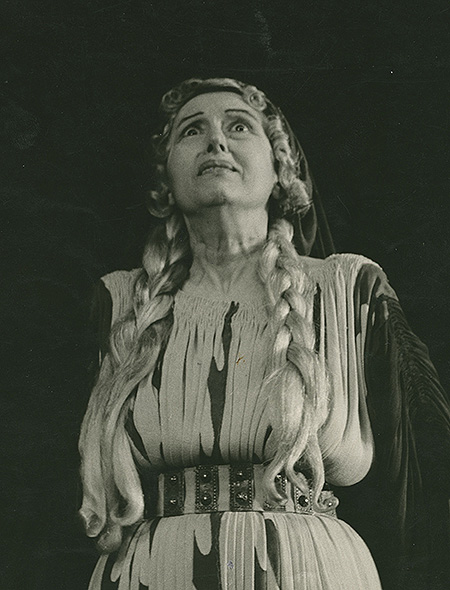
Katina Paxinou, Ecuba by Euripides, National Theatre of Greece. Epidaurus, 1955.
Photographic Archive of the National Theatre of Greece
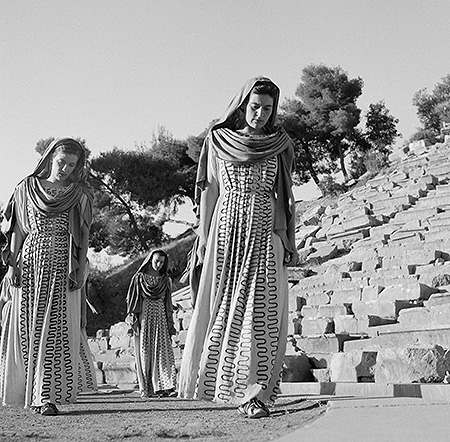
Hippolytus by Euripides, National Theatre of Greece, Epidaurus, 1954. Photographic Archive of the Benakis Museum (Photographer: Dimitris Charisiades)
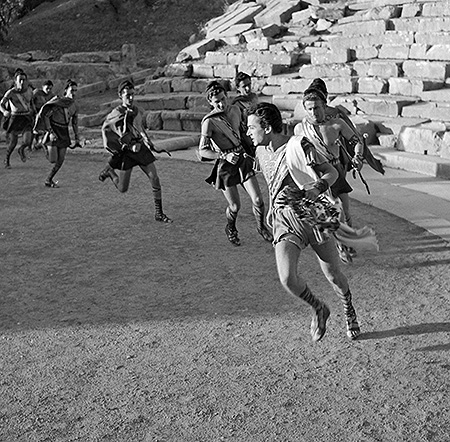
Hippolytus by Euripides, National Theatre of Greece Epidaurus, 1954. Photographic Archive of the Benakis Museum (Photographer: Dimitris Charisiades)

Lysistrata by Aristophanes National Theatre of Greece. Epidaurus 1957. Photographic Archive of the Benakis Museum (Photographer: Dimitris Charisiades

Alexis Minotis Oedipus Rex by Sophocles, National Theatre of Greece. Epidaurus 1955. Photographic Archive of the National Theatre of Greece

Katina Paxinou, Ecuba by Euripides, National Theatre of Greece. Epidaurus, 1955.
Photographic Archive of the National Theatre of Greece

Hippolytus by Euripides, National Theatre of Greece, Epidaurus, 1954. Photographic Archive of the Benakis Museum (Photographer: Dimitris Charisiades)

Hippolytus by Euripides, National Theatre of Greece Epidaurus, 1954. Photographic Archive of the Benakis Museum (Photographer: Dimitris Charisiades)

Lysistrata by Aristophanes National Theatre of Greece. Epidaurus 1957. Photographic Archive of the Benakis Museum (Photographer: Dimitris Charisiades

Alexis Minotis Oedipus Rex by Sophocles, National Theatre of Greece. Epidaurus 1955. Photographic Archive of the National Theatre of Greece
1959
The Birds directed by Karolos Koun
In 1959, the Theatro Technis (Arts Theatre) stages The Birds by Aristophanes at the Odeon of Herod Atticus, directed by Karolos Koun. The scenery and costume are the work of Yannis Tsarouchis, the music by Manos Chatzidakis, the choreography is by Rallou Manou and the translation by Vasilis Rotas.
The performance was pioneering, as Koun brought Attic comedy to life, stressing its timeless qualities and searching for its relevance to modern times.
However, the performances were banned by royal decree after the 'scandal' of the sight of an ancient priest dressed in Orthodox vestments, reciting his lines as a religious chant.
Over the following decades, the performance, with choreography by Zouzou Nikoloudi, was repeated often in Greece and abroad, gaining international praise. In 1975 it was performed at Epidaurus, breaking the monopoly of the National Theatre of Greece
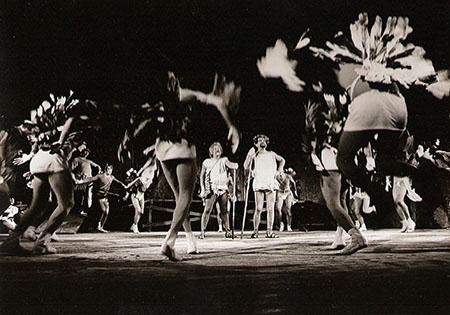
Photo taken during the performance. Archive of the Greek Arts Theatre Karolos Koun (Theatro Technis Karolos Koun)

Photo taken during the performance. Archive of the Greek Arts Theatre Karolos Koun (Theatro Technis Karolos Koun)
1960
Electra directed by Dimitris Rontiris – Theatre of Piraeus
The performance of Electra by Sophocles, directed by Dimitris Rontiris and first performed in 1958, travels the world, promoting ancient Greek tragedy. The lead role is played by Aspasia Papanathasiou, who wins the first prize in the Theatre Festival of Nations in Paris

Electra by Sophocles, Theater of Piraeus. Los Angeles, 1961. Hellenic Literary and Historical Archive (E.L.I.A. – M.I.E.T.) Aspasia Papathanassiou Archive

Electra by Sophocles, Theater of Piraeus. Los Angeles, 1961. Hellenic Literary and Historical Archive (E.L.I.A. – M.I.E.T.) Aspasia Papathanassiou Archive
1961
Medea played by Maria Callas
The production of Medea by Luigi Cherubini in 1961 is the first performance of opera at Epidaurus. Lyric theatre, opera, often takes its themes from ancient drama. In 1797 Cherubini had taken the myth of Medea by Euripides, and given emphasis to the psychological background of the heroine. The leading role was played with great success by the Greek soprano, Maria Callas. The performance was directed by Alexis Minotis. The scenery and costumes were the work of Giannis Tsarouchis.

Maria Callas and Alexis Minotis, Medea by Cherubini. Dallas, 1958. Hellenic Literary and Historical Archive (E.L.I.A. – M.I.E.T.) Archive of Katina Paxinou and Alexis Minotis.

Maria Callas and Alexis Minotis, Medea by Cherubini. Dallas, 1958. Hellenic Literary and Historical Archive (E.L.I.A. – M.I.E.T.) Archive of Katina Paxinou and Alexis Minotis.
1975 και 1976
The ancient drama after the fall of the Greek military junta
After the fall of the Greek military junta in 1974 and the return to democracy, the festival at Epidaurus no longer includes just National Theatre of Greece performances. New directors and companies present ancient theatre, bringing a freshness to the festival.
In 1975, the National Theatre of Northern Greece performed Electra by Sophocles at Epidaurus. The following year, Medea by Euripides met with great success both in Greece and abroad. The leading role in the American performances was played by Irene Pappa, and in Greece by Melina Mercouri.
The director of both performances was Minos Volanakis. He was also responsible for translating both plays with theatricality and sensitivity. He immersed himself in ancient drama and performed the work of the dramatic poets with a new approach.
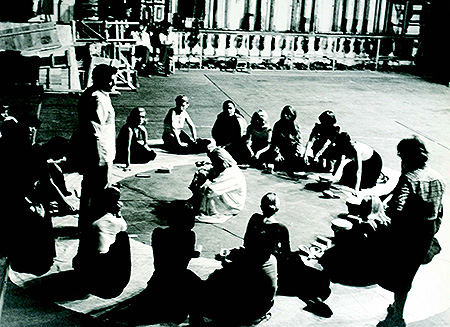
The members of the performance Medea by Euripides during the rehearsal, 1976. Archive of the National Theatre of Northern Greece (Photographer: Socrates Iordanides)
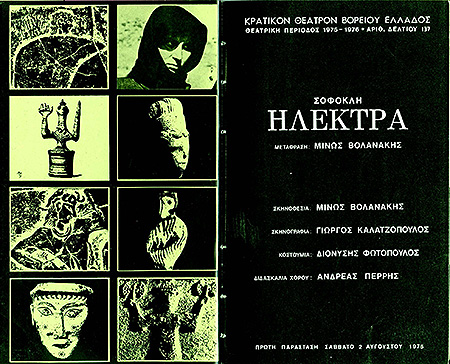
The programme of the performance Electra by Sophocles, National Theatre of Northern Greece, 1975. Archive of the National Theatre of Northern Greece (Photographer: Socrates Iordanides)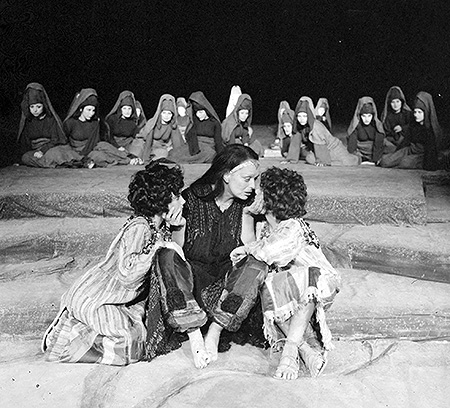
Melina Mercouri, Medea by Euripides, National Theatre of Northern Greece. Epidaurus, 1976. Archive of the National Theatre of Northern Greece (Photographer: Socrates Iordanides)

The members of the performance Medea by Euripides during the rehearsal, 1976. Archive of the National Theatre of Northern Greece (Photographer: Socrates Iordanides)

The programme of the performance Electra by Sophocles, National Theatre of Northern Greece, 1975. Archive of the National Theatre of Northern Greece (Photographer: Socrates Iordanides)

Melina Mercouri, Medea by Euripides, National Theatre of Northern Greece. Epidaurus, 1976. Archive of the National Theatre of Northern Greece (Photographer: Socrates Iordanides)
1977
The Trojan Women directed by Yannis Tsarouchis
In 1977, the artist Yannis Tsarouchis presents The Trojan Women by Euripides in a carpark in Kaplanon St, in the centre of Athens. He is responsible for the scenery, the costumes, the translation and the direction.
The performance re-examined the relationship between ancient drama and the site of ancient theatres. Tsarouchis chose the abandoned building to highlight the point of the play: the pain caused by war.
The captured Trojan women wore modern clothes, like refugees from Asia Minor or the women of Cyprus. Tsarouchis used the ancient myth to comment on modern Greek history.
He himself said, 'I didn't want to bring the play closer to us, but to show how close it already is...'

Model of the scene and costumes by Yannis Tsarouchis for the performance Trojan Women by Euripides, 1977. Yannis Tsarouchis Foundation.

Model of the scene and costumes by Yannis Tsarouchis for the performance Trojan Women by Euripides, 1977. Yannis Tsarouchis Foundation.
1986
The Bacchae directed by Theodoros Terzopoulos
The production of the Bacchae by Euripides, directed by Theodoros Terzopoulos, adds another dimension to the revival of ancient drama in Greece.
The director and founder of the Attis theatre freed ancient tragedy from the traditional style of performance. He placed emphasis on acting with intense physical expression. In his productions he created powerful images on stage, with strong ritualistic elements.

Bacchae by Euripides, Attis theatre, directed by Theodoros Terzopoulos. Berlin, Berliner Ensemble, 1987 (Photographer: Pierre Guillaume)
Bacchae by Euripides, Attis theatre, directed by Theodoros Terzopoulos Fribourg, Ihnenhof Alte Uni, 1987

Bacchae by Euripides, Attis theatre, directed by Theodoros Terzopoulos. Berlin, Berliner Ensemble, 1987 (Photographer: Pierre Guillaume)

Bacchae by Euripides, Attis theatre, directed by Theodoros Terzopoulos Fribourg, Ihnenhof Alte Uni, 1987



